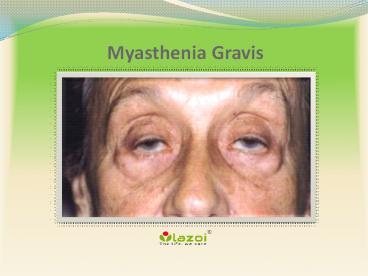Myasthenia Gravis: Symptoms, Causes, diagnosis and treatment - PowerPoint PPT Presentation
Title:
Myasthenia Gravis: Symptoms, Causes, diagnosis and treatment
Description:
Myasthenia Gravis is a neuromuscular disorder primarily characterized by muscle weakness and muscle fatigue. – PowerPoint PPT presentation
Number of Views:244
Title: Myasthenia Gravis: Symptoms, Causes, diagnosis and treatment
1
Myasthenia Gravis
2
Myasthenia Gravis
- Myasthenia Gravis is a neuromuscular disorder
primarily characterized by muscle weakness and
muscle fatigue. Although the disorder usually
becomes apparent during adulthood, symptom onset
may occur at any age. The condition may be
restricted to certain muscle groups, particularly
those of the eyes (ocular myasthenia gravis), or
may become more generalized (generalized
myasthenia gravis), involving multiple muscle
groups. Most individuals with myasthenia gravis
develop weakness and drooping of the eyelids
(ptosis) weakness of eye muscles, resulting in
double vision (diplopia) and excessive muscle
fatigue following activity.
3
What are the causes of Myasthenia Gravis?
- Myasthenia Gravis is a neuromuscular
disorder that is usually caused by an autoimmune
problem. Autoimmune disorders occur when the
immune system mistakenly attacks healthy tissue.
In this condition, antibodies (proteins which
normally attack foreign, harmful substances in
the body) attack the neurotransmitter substance
called acetylcholine, which is a crucial
substance for nerve cell and muscle
communication. This results in the muscle
weakness that characterizes the condition. The
exact cause of this autoimmune reaction is
unclear to the doctors.
4
Who is at risk?
- Myasthenia Gravis is not inherited, and it is
not contagious. It is not clear why people
develop the disorder, although some researchers
believe it could be from a genetic problem. For
women, the disorder usually starts in their 20s
and 30s for men, usually after age 50.
5
Symptoms
- The main symptom of Myasthenia Gravis is
weakness in the voluntary skeletal muscles, which
are the muscles under your control. This weakness
occurs with activity and can get better with
rest. The failure of the muscles to contract
normally occurs because they cannot respond to
the nerve impulse. This is considered to be a
blocked communication between nerve and muscle,
and without the proper transmission of the
impulse, weakness results. Weakness associated
with MyastheniaGravis typically gets worse with
more activity and improves with rest. Symptoms
may include - Trouble talking
- Problems walking up stairs or lifting objects
6
Symptoms
Continue
- Facial paralysis
- Difficulty breathing because of muscle weakness
- Difficulty swallowing or chewing
- Fatigue
- Hoarse voice
- Drooping of eyelid
- Double vision
- Not everyone will have every symptom, and the
degree of muscle weakness can change from day to
day. The disease typically progresses over time
if left untreated.
7
How Myasthenia Gravis is diagnosed?
- Your doctor will perform a complete physical
exam, as well as take a detailed history of
symptoms. He or she will also do a neurological
exam. This may consist of - Checking your reflexes
- Looking for muscle weakness
- Checking for muscle tone
- Making certain your eyes move properly
- Testing sensation in different areas of your body
- Seeing if you can perform certain movements, like
touching your finger to your nose
8
How Myasthenia Gravis is diagnosed?
Continue
- Other tests that can help your doctor diagnose
the condition include Repetitive nerve
stimulation test - Blood testing for antibodies associated with
Myasthenia Gravis - Edrophonium (Tensilon) test a drug called
Tensilon (or a placebo) is injected, and the
patient is asked to perform muscle movements
under doctor observation - Imaging of the chest, using CT scans or MRI, to
rule out a tumour
9
Treatments
- Common treatments for myasthenia gravis
includeMedications such as Mestinon
(pyridostigmine bromide) and Prostigmin
(neostigmine bromide) - Corticosteroid medications such as prednisone
- Medications that suppress the immune system, such
as Imuran (azathioprine) and cyclosporine - Removal of the thymus gland (thymectomy), the
main gland in the immune system - Plasma exchange (plasmapheresis), in which the
person's blood plasma containing the abnormal
antibodies is removed and fresh plasma is put
back
10
Treatments
Continue
- People with myasthenia gravis can in most cases
lead full lives. Sometimes the muscle weakness
resolves to the point of not being a problem
(called spontaneous remission). For some people,
the weakness is only in the eyelids. For others,
the weakness progresses to a point and stays at
that level. Rarely, and usually in the first two
years of the disorder, the weakness might extend
to the muscles that control breathing, and the
person will have to be hospitalized. There is no
cure for myasthenia gravis, but the treatments
are usually effective in minimizing its problems.
11
CONNECT WITH US
- Logon to
- www.lazoi.com
- Like us on Facebook
- https//www.facebook.com/LazoiTheLife
- Follow us on Twitter
- https//www.twitter.com/lazoithelife
- Follow us on Pinterest
- https//www.in.pinterest.com/lazoithelife































